
The Intro:
So it looks like I’m keeping my position after blundering on a key term in my last article and asking Jason to eat a shoe. If you don’t know what I’m talking about, let’s keep it that way :)
A short belated introduction, my name is Tim Enmou Gao and I graduated last year with an undergraduate degree in economics and accounting. I picked up Magic again after a ten-year hiatus and went straight to Modern. I am a Modernophile at heart and prefer to play tempo decks. I am currently playing Jeff Hoogland’s UR Spellstutter deck.
Today, I wanted to cover the topic of speculation.
What is a speculation? A speculation is by definition a conjecture, there are no 100% speculations in Magic because Wizards of the Coast can at any moment make a new announcement. However, that doesn’t mean that all speculations are made equal.
I believe that experience is the best teacher, so I’ll be going over my first experience speculating. I hope that you’ll be able to find some value in reading the article.
The Deck:
I first had the idea speculating on [card]Restore Balance[/card] deck in July this year after seeing the deck 4-0/3-1 on a couple Modern Daily Events within a week. Being that the deck didn’t really make any sense by looking at it, I started play testing a [card]Restore Balance[/card] deck on TappedOut.net because as with all things Modern, I wanted to figure out how the deck worked.
Let me explain.
By casting [card]Violent Outburst[/card], [card]Ardent Plea[/card], or [card]Demonic Dread[/card], the deck can effectively cascade into its key card, [card]Restore Balance[/card]. The deck runs a redundant number of cascade spells because it usually doesn’t run any innate draw or search mechanics. Casting a Modern-legal [card]Balance[/card] isn’t a big deal, but there are ways for the [card]Restore Balance[/card] deck to abuse the [card]Balance[/card] effect.
First and foremost, suspending a [card]Greater Gargadon[/card] before cascading into [card]Restore Balance[/card] adds an [card]Armageddon[/card] to the [card]Wrath of God[/card] effect! You can sacrifice all your lands to make your opponent sacrifice all his/her land while [card]Restore Balance[/card] is on the stack.
But it gets even better.
By having a hand of cheap suspend creatures, we can add on a [card]Mind Sludge[/card] discard effect to our third-turn [card]Wrath of God[/card]-plus-[card]Armageddon[/card]. [card]Simian Spirit Guide[/card] lets us play it out even faster and makes the opponent discard more cards.
The deck finishes by powering through with its many suspend creatures, usually with [card]Beast Within[/card] backup, because all its creatures are larger than the 3/3. By this point, the opponent should have few if any cards, few if any lands, and practically no board presence.
The Factors:
After playtesting the deck for about a week, I knew that there was no way that [card]Restore Balance[/card] is a $0.50 card when it had the potential to be the most powerful spell in Modern. Here are some other attributes going for the deck:
- The deck does not rely on the graveyard, any specific type of permanent, and there are currently no hate cards in the Modern meta that are widely played (i.e., [card]Ethersworn Canonist[/card], [card]Rule of Law[/card]). I didn’t realize this until a few days into playtesting and finally giving up the Borderpost version in favor of being free from hate cards.
- There is a close to zero chance of a reprint because Modern Masters, the last set in a while to have the the Suspend mechanic, skipped over the card. Suspend is largely an unpopular mechanic for Wizards because it is confusing for newer players.
- There is a Johnny element to this deck. It is fun to “go off” and wipe out the opponent’s lands, creatures, and hand, after which your suspend creature takes over the board. Total devastation is the name of the game.
There are a few other reasons why I felt that [card]Restore Balance[/card] was a spec that can reasonably hit.
- At the time, [card]Living End[/card] had recently risen in popularity because of GP Kansas City, where the [card]Living End[/card] deck reached second place. In terms of the main combo, the decks were very similar. However, whereas Living End was a $10 card at the time, Restore Balance was only $0.50.
- Theros was the next set to be released, and it was rumored to be based around enchantments. [card]Restore Balance[/card] is also the only deck in Modern that can play [card]Idyllic Tutor[/card] as a way to find [card]Ardent Plea[/card] to cascade, and it was conceivable that Theros would provide better 3CMC enchantment-tutor targets.
- I began to see copies on the internet disappearing at the $0.50 price point, and it was clear to me that I wasn’t the only who saw the opportunity to go deep. This was an opportunity for me to experience speculating first hand.
It should come as no surprise that I also have a number of caveats with any spec. The following is a list of reasoning that it might not be the right the spec for me.
- I haven’t hit a spec before, and the question was whether I wanted to throw over $100 on a single card that has no real precedent. That’s a lot of money to potentially throw away.
- The weakness of the [card]Restore Balance[/card] deck is that it folds to consistency and discard. If it becomes a deck, it would be the one and only five color Modern deck. There is no precedent of a five-color combo deck, as redundant as its cards may be.
- With a good amount of playtesting, the deck loses to early discard, and its manabase is not always going to get there no matter how many all color lands it runs. Consistency is an issue in larger tournaments that have more rounds, and it could very well be that [card]Restore Balance[/card] would never be a competitive deck.
The Actions:
With all these factors in mind, I’ve decided to go as reasonably deep into the spec as I can, because I am reasonably confident that the price isn’t going to be any cheaper and the card has great upside. In my first round of buying I went about 100 cards deep, which came out to be about $60 at $0.60 each after shipping.
On the same night, I contacted Jason Alt with a full list of reasons why I think the spec could hit and what he thought about the spec. It felt far-fetched that a pro financier would respond to a random Redditor, but I thought it was worth a shot. I was pleasantly surprised when he quickly responded affirming the spec. Here are a few quotes of what he wrote:
“If you bought restore balance at $0.60 you almost can’t lose.”
“It seems like the card keeps popping up. You’re doing everything I’d do and your thought process seems solid. I can’t find any fault. Take a chance on this. Go a little deeper.”
“You are confident in this spec – enough to buy 100 copies before even running it by me. I take it you’ve never hit before and that’s why you’re reluctant. Go deep. You can lose, but you can’t lose TOO much and if you hit, this card could be a few bucks on a buylist.”
I then stayed up another hour and bought some 75 more copies of the card, culminating in an average price of $0.62. Amazing things happen when you hear what you want to hear!
The Present:
Today, the median TCG price is $1.64, down from $1.78 from about a week ago. Prices have risen over the past few months and show no signs of stopping from doing so.
So far, I’ve sold a playset on eBay for $10.06 and another 51 cards off a buylist for $1.15 each for a total of $58.65. Not even remotely close to amazing, but I’m happy about my first spec!
I currently hold another 120 copies, averaging at $0.37 per copy, so I’m quite certain I’m in the money for this spec.
The Takeaway:
- Do your homework. This is the foremost factor for how you can hit a spec. While you can’t have a spec that will hit 100% of the time, you can do your best to make sure that the chances are as good as you’re willing to risk.
- The old adage stands, “Buy low, sell high.” Find a card that you believe is underpriced, preferably bulk or close to bulk, and go as deep as you reasonably can. You can lose, but you can’t lose too much, and the potential for upside is worth the risk.
- Keep track of all your cards, prices, copies, in an Excel file to know where you are. I can’t imagine trying to figure out whether I’m losing, breaking even, or making money on a spec without keeping track.
I wish I can figure out which vendor sent me this “NM” copy…
Lastly, here’s another excerpt from Jason because all you readers obviously don’t get enough of him from just his weekly Quietly Speculation Alticle. All the value!
“One technique if the price goes up and you don’t know whether it will go up again is to sell enough copies at the first bump that you break even, then you hold the rest. If they go up more, it’s all profit. If they go down, it’s still all profit. If they stay the same – guess what! Profit. Breaking even as early as possible is the single most important lesson I can teach for your first spec.”
Thanks for reading!
Enmou (Tim) Gao
@TimEnGao on Twitter
2 comments on Enmou Gao – Intro to Speculation
Leave a Reply to Enmou Gao Cancel reply
You must be logged in to post a comment.




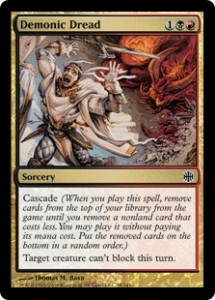
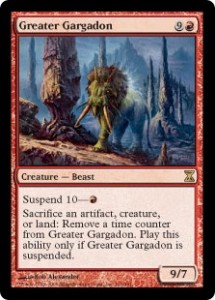
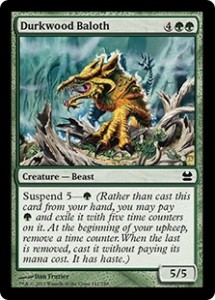

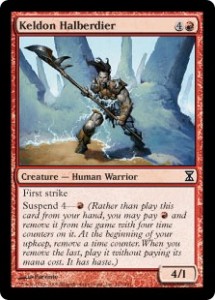
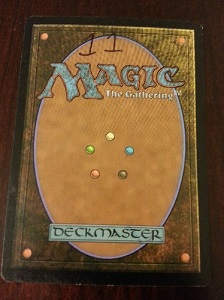
I’d be interested in speccing on foil restore balances since most of the deck is fairly easy to foil out since they’re either commons or don’t see play in any other constructed decks.
Yup, currently holding 22 foil copies! They’re not doing so hot though, prices haven’t moved at all since I bought them. I do dig that when you’re cascading, you know when to stop when you spot the foil. Same deal with using foil Delvers so you don’t forget the triggers.